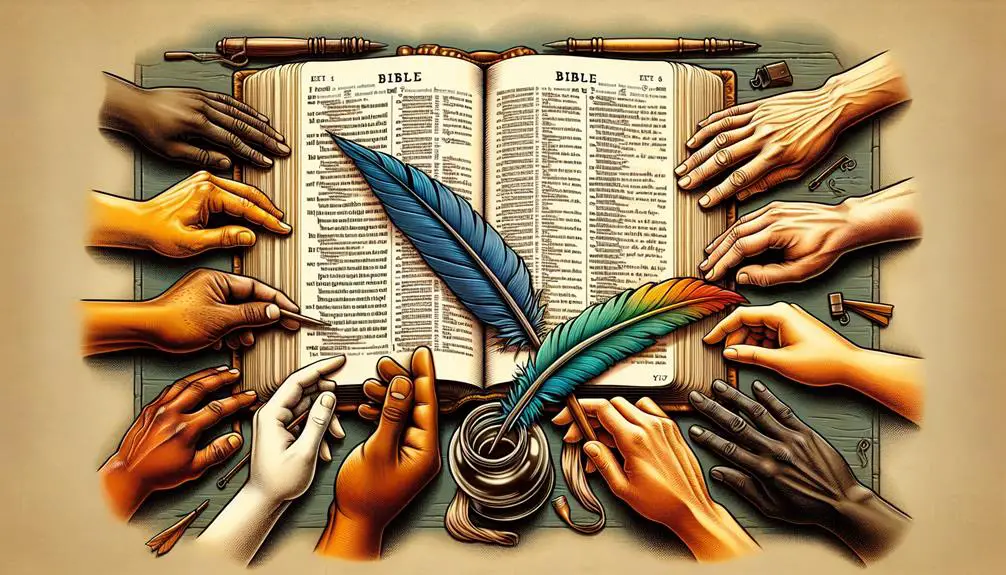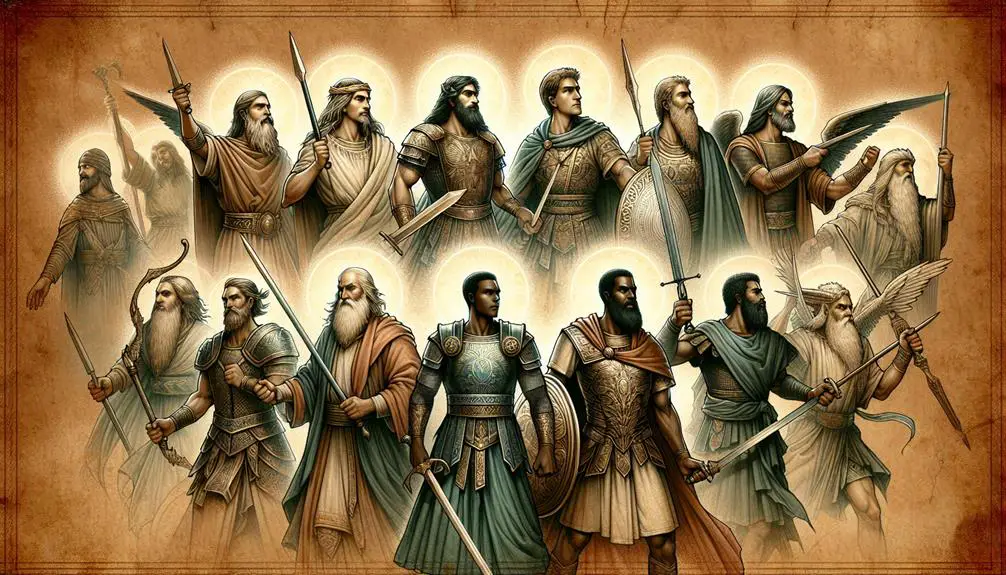Marvel at the surprising frequency of left-handed references in the Bible, revealing untold stories and cultural insights.

How Many Times Is Left Handed Mentioned in the Bible
You might think the Bible has a 'left' or 'right' preference, but how often does it actually tip its hand?
In the ancient texts, left-handedness pops up more times than you'd expect, subtly woven into narratives and character descriptions.
This mention is not just a trivial fact; it carries weight in cultural and religious contexts, shaping our understanding of biblical heroes and societal norms.
So, let's unpack the layers behind these seemingly simple references.
You'll find there's more to the story, inviting you to explore the depths of interpretation and significance behind each mention.
Key Takeaways
- Left-handedness is mentioned several times, highlighting unique individuals in biblical narratives.
- Notable left-handed figures include Ehud and warriors from the tribe of Benjamin.
- These instances often symbolize divine provision or strategic advantage.
- The mentions reflect societal attitudes towards left-handedness and its symbolic meanings.
Biblical Instances of Left-Handedness

Throughout the Bible, several instances of left-handed individuals are noted, each carrying significant implications for understanding biblical narratives and cultural perceptions of left-handedness. The left-handed stigma, deeply embedded in many cultures, finds its reflection even in these ancient texts, suggesting a nuanced view of left-handed individuals.
For instance, in the Book of Judges, Ehud, a left-handed man from the tribe of Benjamin, is described as using his left hand to carry out a decisive act of deliverance for Israel. This detail isn't merely incidental; it's pivotal in understanding how his left-handedness gave him a strategic advantage, challenging contemporary stigmas associated with left-handedness.
Moreover, biblical references to left-handedness often underscore a departure from the norm, which, in a predominantly right-handed world, marked these individuals as unique. This uniqueness wasn't always viewed negatively. Instead, in certain narratives, it's portrayed as a divine provision, a means through which God's purposes were fulfilled in unexpected ways. Analyzing these references offers insight into the complexity of biblical characters and suggests that left-handedness, rather than being merely a physical trait, held symbolic significance within the biblical text.
Cultural Significance of Handedness

In many cultures, the choice between using the right or left hand isn't merely a matter of preference but embodies profound societal and cultural implications. Hand dominance myths have woven themselves deeply into the fabric of societal norms, influencing perceptions and behaviors towards individuals based on their preferred hand use.
Historically, right-handedness was often associated with strength, purity, and intelligence, while left-handedness was unfairly linked with weakness, impurity, and cunning. This societal bias evolution can be traced back to ancient texts and practices, where the right hand was preferred for rituals and oaths, casting a shadow over left-handedness.
The cultural significance of handedness isn't just an artifact of historical curiosity but continues to influence modern societal norms and personal interactions. Educational systems, religious practices, and even language reflect a bias towards right-handedness, with idioms and expressions often casting left-handedness in a negative light. This perpetuates stereotypes and myths about hand dominance, underscoring the need for a deeper understanding of the origins and implications of these cultural biases.
Analyzing the evolution of societal bias towards handedness reveals much about how cultures interpret physical traits and assign moral and intellectual qualities based on such arbitrary distinctions.
Left-Handed Heroes in Scripture

Exploring the cultural biases against left-handedness reveals a fascinating counter-narrative within scripture, where left-handed heroes emerge as pivotal figures. This subversion of expectations not only highlights the unique left-handed advantage in combat but also enriches the warrior symbolism woven through biblical narratives. The stories of these individuals offer a deeper understanding of how left-handedness was perceived and utilized in ancient times.
- Ehud: A judge of Israel, Ehud's left-handedness allowed him to conceal a sword and assassinate the Moabite king Eglon, delivering Israel from oppression. His story illustrates the tactical advantage of being left-handed in a right-handed world.
- The Benjamites: This tribe produced an elite group of warriors, renowned for their skill with the sling and bow, capable of using both hands but favoring the left. Their ambidexterity symbolizes adaptability and exceptional prowess in battle.
- Eglon's Guards: Their failure to anticipate Ehud's left-handed attack underscores the unexpected advantage left-handed individuals could leverage.
- Judges 20:16: References 700 select troops who were left-handed, each able to sling a stone at a hair and not miss, showcasing the precision and skill uniquely honed by left-handed warriors.
These narratives collectively challenge and expand our understanding of left-handedness within a historical and scriptural context, illustrating that what's often seen as a disadvantage can, in fact, be a profound source of strength and strategy.
Interpretations of Left-Handed Mentions

Analyzing the mentions of left-handedness in the Bible, you'll uncover a multifaceted interpretation that reflects societal attitudes and divine symbolism. Historically, left-handed individuals were often viewed with a mix of suspicion and awe. This duality is mirrored in biblical narratives, where being left-handed could symbolize both deviation from the norm and a unique, God-given advantage.
The historical context is crucial. In ancient societies, the right hand was typically associated with strength, skill, and purity. Thus, left-handed characters in the Bible stand out, not just for their rarity but for the symbolic meanings attached to their left-handedness. It suggests a break from tradition or an unexpected method of achieving God's will.
Moreover, the symbolic meanings of left-handedness in the Bible are layered and complex. It's not merely about being different or special; it's often indicative of God's power to use the unexpected to fulfill divine purposes. This interpretation challenges you to look beyond surface-level readings and consider the deeper, symbolic significance of left-handedness within the biblical text and the broader historical context.
Lessons From Left-Handed Characters

Building on the complex symbolism of left-handedness, we now turn our attention to the lessons offered by left-handed characters in the Bible, shedding light on how their unique traits convey deeper spiritual and moral teachings. The narratives surrounding these individuals not only challenge the left-handed stigma but also illuminate the broader themes of diversity, resilience, and the unexpected ways in which divine favor can manifest.
- Overcoming Stigma: Left-handed characters in the Bible often defy societal expectations and prejudices. Their stories teach us about the importance of embracing our differences and using them to fulfill our destinies.
- Utilizing Unique Abilities: Their ambidextrous abilities or preference for the left hand is sometimes portrayed as a strategic advantage, suggesting that what makes us different can be our greatest strength.
- Surprising Victory: These characters frequently achieve victory against overwhelming odds, illustrating that success often comes from the most unexpected places.
- Divine Choice: Their stories underscore the idea that divine selection and blessing don't conform to human standards but rather celebrate the uniqueness of the individual.
In exploring these lessons, you're invited to reflect on the broader implications of left-handedness beyond the biblical context, considering how these narratives continue to inspire and challenge prevailing norms.
Frequently Asked Questions
How Does Modern Science Explain the Occurrence of Left-Handedness, and Does It Align With Biblical Interpretations?
Modern science attributes left-handedness to genetic factors, a view that diverges from biblical interpretations.
You'll find that scientific research emphasizes the role of genetics and brain hemisphere functions in determining hand preference. This perspective contrasts with cultural perceptions and biblical narratives, which often imbue left-handedness with symbolic meanings.
While science seeks to explain it through biological mechanisms, the Bible presents it within a context of cultural and symbolic significance.
Are There Any Specific Rituals or Practices Prescribed in the Bible for Left-Handed Individuals?
You're navigating a world where left-handedness carries a unique set of cultural perceptions, akin to finding your way in a city where all signs are flipped.
Despite historical stigmas, the Bible doesn't prescribe specific rituals or practices for left-handed individuals. Instead, it offers stories devoid of left-handed stigma, focusing on character and faith over physical traits.
This lack of directive encourages a scholarly reevaluation of our cultural perceptions around left-handedness.
How Have Different Translations of the Bible Affected the Portrayal and Understanding of Left-Handed Characters?
You've noticed that different Bible translations can significantly influence your understanding of left-handed characters. Translation accuracy isn't just about literal word-for-word conversion; it's deeply intertwined with cultural interpretations.
As translators navigate these waters, they sometimes reshape how these individuals are perceived, shedding light on or obscuring their roles and significance. This variance in portrayal underscores the importance of considering both the historical context and the translator's perspective when interpreting these texts.
In Contemporary Religious Practices, Is There Any Significance Still Attached to Being Left-Handed?
In contemporary religious practices, the significance attached to being left-handed has diminished, though remnants of past stigmas persist. Cultural perceptions have evolved, but the shadow of historical biases lingers in some traditions and beliefs.
Analyzing these shifts reveals a complex interplay between tradition and modernity, where the once prevalent left-handed stigma is gradually being reassessed. Today's approach is more inclusive, yet the echoes of old views subtly influence current practices.
Does the Bible Provide Any Guidance or Advice Specifically for Left-Handed Individuals on How to Navigate a Predominantly Right-Handed World?
Ever wondered how the Bible guides left-handed individuals in a right-dominated world?
Surprisingly, it doesn't directly address left-handed stigma or provide explicit advice for societal adaptation. Instead, its narratives occasionally highlight left-handed figures without stigmatizing them, subtly encouraging you to navigate your uniqueness in any environment.
This absence of direct guidance invites a broader interpretation, encouraging you to find personal strength and adaptability in your distinctiveness.
Conclusion
In sum, Scripture subtly signals the significance of southpaws, showcasing them in scenarios that surpass mere societal standings.
You've witnessed how these left-handed legends not only leveraged their uniqueness in battles but also brought broader biblical lessons to light.
This analysis accentuates the ancient attitudes toward asymmetry, affirming that left-handedness, far from being a mere physical feature, fulfilled a figurative function, framing these individuals as instrumental in imparting invaluable insights.
Through thorough thematic threads, these narratives navigate the nuanced nexus of culture, character, and conquest.



Sign up